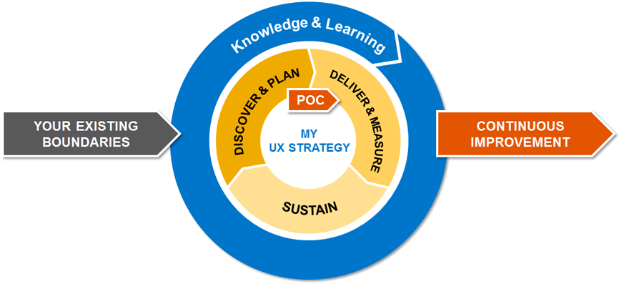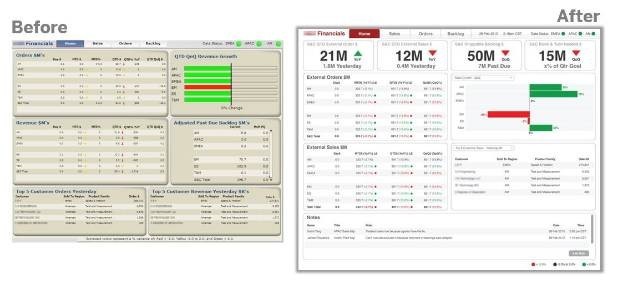your journey
Create Your Company’s UX Strategy
Helpful advice from SAP.
By now, most IT leaders have become convinced of the need to move their organizations away from a mindset of delivering functions and features, and move toward a focus that puts the user’s true needs at the center, employing design thinking principles.

Discover and Plan – Where to start?
Why should you create your own UX strategy? Where do you start, and how do you embrace UX across the enterprise? From my experience, the best way to begin is by analyzing three elements:
- User satisfaction. Which user groups / roles are most dissatisfied with the solution they use?
- Reach. How many people use or could use those solutions – just five or thousands? (Note: User adoption metrics can be obtained from your SAP systems. These metrics reveal the most frequently used transactions by users.)
- Value potential. If a UX improvement were to be made in a particular area, what is the business benefit, in terms of increased productivity, reduced training costs, fewer errors, etc.? One way to gauge this is with our UX value calculator. Compare that value with the implementation cost to find the ROI.
Once you’ve done this analysis, it will quickly become clear which scenarios make the most sense for a UX investment (ensuring, of course, that they are also aligned with your business and IT strategy). From that list, you can create your UX roadmap by assembling the projects in order of priority. While it might be tempting to start with the highest value project, it’s essential to begin with a project that ensures a quick win. The highest value projects may take years to implement and a long time to show any value. By starting with a quick win that improves UX in weeks or months, you can more quickly show the value of this user-centered approach. Showing value will inspire your management team to free up more budget for more UX efforts.
Deliver & Measure – Customer Examples
A great example is a project we did with Coca-Cola HBC. They run several call centers for customers ordering by phone. As an additional sales channel, Coca-Cola HBC wanted to offer a web shop to enable customers to place orders in a few clicks. The primarily challenge was to ensure high customer acceptance of the future web shop. To make ordering items as easy as shopping at Amazon for customers throughout Europe, Africa and Russia, the real needs and requirements of the end users had to be discovered.

Another great example of a quick win is a project we did with another customer. The users complained about the usability of a dashboard that was created with an SAP BusinessObjects tool. Our first step was to observe how users currently work with the dashboard and what their needs and pain points are. We observed that the most important information for the users were just a few KPIs.
Most of the users were lost using the existing dashboard, because the structure and functionality was unclear to them. We consolidated all findings and re-designed the dashboard to fit the needs of the end users. Do you know what the most interesting outcome was? The changes could be done with the same tool they used to create the initial dashboard. It could be easily implemented in the existing environment and users really like the new dashboard.

Sustain – Where does it lead to?
That outcome is exactly what you want to happen. You probably do some more UX projects and excite more users, but once more business units take an interest in UX, you’ll need to begin developing the needed skills to scale your efforts. And that leads to the next step in the UX strategy: developing a UX center of excellence, with the following goals:
- Establishing design as a competitive advantage
- Influencing organizations and processes to include design methods
- Establishing design skills and a design mindset
- Providing relevant tools and infrastructure
So where does this strategy lead? By bringing design skills in your organizations you will experience working and engaging with your end users and business units in a new way. These skills will not only help you to improve user experience, but also help you to build a culture of innovation.
The final outcome is the transformation of IT into a value generator and the transition of the CIO into the role of chief innovation officer. Fortified by the growing understanding within the enterprise about the value of UX, the CIO can use that energy to build a culture of innovation, through the right people, processes and new types of workspaces. New possibilities for value will begin to reveal themselves as the UX mindset takes hold and is combined with exciting new solutions, technologies and tools such as SAP Fiori, SAP Web IDE, SAP Screen Personas or SAP HANA.
By following this step-by-step approach, you can move your organization not only into a UX mindset but into the role of value-generator through innovation. And in the end, that’s what UX is all about: generating value through innovation.
Share this:

Neil ran his first SAP transformation programme in his early twenties. He spent the next 21 years working both client side and for various consultancies running numerous SAP programmes. After successfully completing over 15 full lifecycles he took a senior leadership/board position and his work moved onto creating the same success for others.